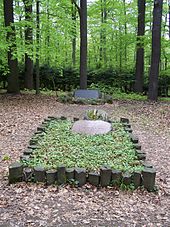Heinrich Cotta
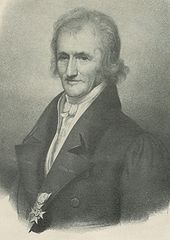
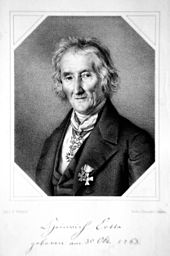
Johann Heinrich Cotta (born October 30, 1763 in the forester's house Kleine Zillbach between Zillbach and Wasungen ; † October 25, 1844 in Tharandt ) was a German forest scientist . As one of the founders of this branch of science, he has achieved world renown.
Live and act
Johann Heinrich Cotta was born in the forester's house in Kleine Zillbach near Wasungen (in the Rhön ) and trained by his father, a princely Weimar forester , from 1778 on and acquitted as a hunter's boy in 1780 . In the years 1784/1785 he studied mathematics, natural and camera sciences at the University of Jena and was then busy with measurements . In this context, he and his father began teaching forestry from 1786. In 1789 Cotta became a ducal-Weimar forest runner .
On May 12, 1795 Heinrich Cotta married his long-time friend Christiane Ortmann, known as Christel. His two eldest sons Friedrich Wilhelm von Cotta (1796 to 1874) and Friedrich August von Cotta (1799 to 1860) also embarked on a career in forestry. His fourth son, Karl Eduard Cotta (1803 to 1872), became a lawyer, and his youngest child, Carl Bernhard von Cotta , was a well-known geologist. However, his son Carl Emil, born in 1801, and his daughter Mathilda, born in 1806, died soon after their birth.
In the year of his marriage in 1795, Heinrich Cotta also received his father's position as a forester in Zillbach, where the Grand Duke of Saxony-Weimar-Eisenach , Carl August, also made the hunting lodge and garden available to him for his forestry lessons. This resulted in a private forestry school, the reputation of which spread quickly and made Cotta known as an excellent teacher. His students included Gottlob König and August Adolph Freiherr von Berlepsch . In 1801 Cotta was appointed a member of the Forestry College in Eisenach , but continued to work primarily in Zillbach. In 1800 he received the Leopoldina's Cothenius Medal .
From 1809 he was in contact with the royal Saxon administration under Friedrich August I , who were looking for a new head of their forest surveying institute. After some negotiations Cotta was finally on 12 December 1810 in Dresden as forest advice and Director of Forestry Survey and Taxation sworn. Since he had also stipulated the right to freely choose his place of residence and to be able to continue his teaching institution there, he decided on the town of Tharandt. He moved there together with his Zillbacher Forstlehranstalt in the spring of 1811. In 1816 it was elevated to the status of the Royal Saxon Forest Academy (today the Department of Forest Sciences at TU Dresden ). It soon had numerous foreign students, although all non-Saxons were considered foreigners at the time. Of the 1,030 students from 1816 to 1844, 472, or 46 percent, were non-Saxons. Of these, 371 (36 percent) came from other German countries, the remaining 101 (10 percent) were actually foreigners, mainly from Russia , Switzerland , Austria and Spain . This is how Cotta influenced forest science around the world. Russian students were particularly fond of attending the Forestry Academy and Tsar Nicholas I awarded him a high Russian medal in recognition of his efforts in this area in 1841.
Cotta was known and appreciated far beyond the actual forest districts and was associated with numerous celebrities of his time. In 1813 Johann Wolfgang von Goethe visited him in Tharandt and in 1819 and 1822 Cotta visited Goethe in Weimar . The subjects of discussion during these visits were, in addition to forestry issues, above all geology and fossils . Cotta, who had been an avid collector all his life , owned a famous mineralogical-geological “petrification collection”, which was one of the most important collections of its time. This collection also attracted other natural scientists to Tharandt, including Alexander von Humboldt in 1830 , who, after Cotta's death, arranged for this collection to be purchased for 3,000 thalers for the “Berlin Cabinet”. This part of the collection alone comprises around 5,000 specimens of plant and animal fossils. Today, items from the collection are kept in the Museum für Naturkunde at the Humboldt University in Berlin (Institute for Paleontology ), the Museum für Naturkunde Chemnitz , the Bergakademie Freiberg , the Museum für Mineralogie und Geologie Dresden and the British Museum of Natural History London.
In the later years of his life Cotta also gave lectures to non-forest audiences, for example in 1829 in the " Flora - Society for Botany and Horticulture in Dresden ". Cotta was director of the forest science department of "Flora" and later its honorary member.
For his 80th birthday, his students planted 80 oaks in the Tharandt Forest , south of what is now the Tharandt Forest Botanical Garden . A year later, on October 25, 1844, Johann Heinrich Cotta died and was buried at this point. The funeral speech was given by von Berlepsch, who also headed the academy for a short transition period until a successor for Cotta was found in October 1845 in Carl Heinrich Edmund von Berg .
Cotta as a consciously commoner
In forestry circles it is often assumed that Johann Heinrich Cotta was ennobled or had a title of nobility. However, this is wrong, as Cotta's biographer Albert Richter pointed out as early as 1950 (all subsequent quotations from it). Although the Cotta family still owned the original nobility letter issued by Emperor Sigismund in 1420 until the fire in Ilmenau in 1752 , they no longer managed the nobility. The family was divided into a southern German and a Saxon-Thuringian tribe. According to later investigations, however, de facto no family relationships should have existed between these two Cotta lines. At the time, however, it was believed in a common descent from Bonaventura Cotta .
Against this background, according to a note by Wilhelm von Cotta, the famous bookseller and publisher Johann Friedrich Cotta had asked Heinrich Cotta in 1817 to take joint steps to renew the nobility. However, this refused due to his democratic and deliberately bourgeois attitude. After all, he had not continued his father's attempt to regain the nobility in 1796 and did not use the Cottasche seal either, but sealed it with an impersonal one. Friedrich Wilhelm von Cotta described his father's attitude in 1860 with these words:
“My father, who, although often enough experienced insulting neglect towards nobles, but had earned himself a great reputation through his services and placed himself in a position in which he believed he could do without the nobility, refused because he thought his sons would like them stand out, then they would not need a renewal of the nobility, because he also considered himself not well-off to take such a step, and because he lived in the hope that the privileges of the nobility would come to an end. "
An attitude that not only significantly hindered Heinrich Cotta's professional advancement, but also led to only part of the southern German family being elevated to the nobility in 1817 and baron in 1822. Another part renewed the nobility in 1859. After Heinrich Cotta's death, however, his three sons Wilhelm, August and Bernhard were also re-awarded the title of nobility on application in 1858 - which led to some criticism in forest newspapers.
Services
Heinrich Cotta is the founder of modern, sustainable forestry and forest science and made the transition from “wood cultivation” to “ silviculture ” as a holistic “science and art at the same time”. Cotta coined the term "silviculture" in the first place, above all through his most famous book Instructions for Silviculture (1817). In the preface to the first issue, he also gave a now famous reason why the new specialist discipline "Forest Science" had become necessary:
“If people left Germany, after 100 years it would be completely overgrown with wood. Since no one was using the latter, it would fertilize the earth and the forests would not only be larger, but also more fertile. If, however, people returned afterwards and made the same demands on wood, forest litter and pasture as they do now, then with the best forestry the forests would not only become smaller but also more sterile. The forests are formed and therefore exist best where there are no people and consequently no forest science at all; And those are therefore perfectly right who say: Otherwise we wouldn’t have had enough forestry and wood, now we have science, but no wood. But one can also rightly say: People who do not need a doctor are healthier than those who do without it having to follow that the doctors are to blame for the diseases. There would be no doctors if there were no diseases and no forest science without a lack of wood. This science is now a child of want and consequently this is its usual companion. "
In his instruction on silviculture , Cotta also introduced the term medium forest and for the first time differentiated between low , medium and high forest . He also advocated maintenance of the stand, for example thinning - in contrast to his contemporary Georg Ludwig Hartig , who primarily understood this to mean “burial”. Cotta called for an almost exaggeratedly cautious thinning from today's point of view, but already spoke out in favor of purification , which was unheard of at the time, as it was a maintenance measure that did not cover costs.
Cotta dealt with almost all areas of forest science in his works. In addition to silviculture, forest management was one of his priorities. After he moved to Tharandt in 1811, he quickly measured the extensive forests of Saxony and set up forest management works. In this context he developed the so-called “surface framework” for the spatial organization of the forest. He presented his views on this in the book Outline of Instructions for the Measurement, Description, Estimation and Forestry Classification of the Woods (1815). Cotta also set up yield tables . His auxiliary tables for foresters and forest taxators (1821), but also the tables for determining the content and value of unprocessed timber (1816), were important tools for forestry as a whole and were reissued over and over again throughout the 19th century. He was also very concerned with calculating the forest value. Within only two decades Cotta managed to bring the severely degraded Saxon forests to an orderly forestry.
Cotta also recognized the non-economic importance of the forest and designated a plenter forest near Dresden, primarily for reasons of beauty . In the Tharandt forest, which he expanded into a “green lecture hall”, he laid a network of aisles and wings. In addition, Cotta was one of the first and at the same time the first forest classics to advocate the establishment of mixed stands, albeit very cautiously . In his time, if at all, mixed stands of beech and oak or beech and hardwood were tolerated at best.
In addition, Cotta, who had been involved in forest teaching for more than 40 years, also made an outstanding contribution as a forestry teacher. In contrast to Hartig, who hardly tolerated contradiction, his nature was gentle and willing to compromise, which was reflected in much stronger differentiations in his writings and his teaching. Nevertheless, Hartig's simple general rules had a far more immediate effect on forestry practice. Because Cotta's thoughts were much more differentiated and more difficult to understand, his teachings only gradually penetrated the forest consciousness. In a certain way he stood between Hartig with his often very schematic general rules and arrow, who already called for a very strong specialization of silviculture according to location-relatedness.
Heinrich Cotta is often referred to as the most important forester ever. In any case, because of his significant contributions to the development of forest science, he is one of the so-called “forest classics”, including Georg Ludwig Hartig, Friedrich Wilhelm Leopold Pfeil , Johann Christian Hundeshagen and his students Carl Justus Heyer and Gottlob König . The Heinrich Cotta Medal is awarded for particularly outstanding achievements in the field of forest science.
Honors
- 1836 - Commander's Cross of the Order of Civil Merit of Saxony
- 1836 - Order of the Red Eagle III. class
- 1836 - Commander's Cross of the Weimar House Order of the White Falcon
- 1841 - Order of St. Vladimir IV class by the Russian Tsar
In addition, Heinrich Cotta was elected honorary president of the forestry section in 1843 during the 7th meeting of German farmers and foresters in Altenburg. At the same time it was decided to dedicate a forest "Cotta-Album", a collection of essays, to him. This work, which was presented to him in his house on October 4, 1844, was the last honor Cotta could receive.
According to the biography of his father Johann Matthäus Bechstein published by Ludwig Bechstein in 1855 , Johann Heinrich Cotta was only the second German forester to have an independent biography written in book form. The work, at the same time a habilitation thesis , Heinrich Cotta. Life and work of a German forester , by Albert Richter published in 1950 by Neumann-Verlag, Radebeul and Berlin.
Monuments and memorials
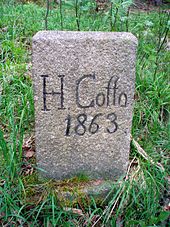
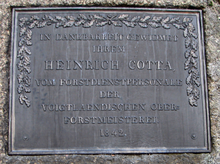
In addition to Tharandt, where there are several monuments in honor of Cotta, his legacy is also lovingly kept alive in his birthplace and first place of work, Zillbach. There is a Heinrich-Cotta-Platz with a memorial stone to the famous son of the place as well as a forest history cabinet dedicated to his memory, which was opened on September 5, 1997. The plantation established by Cotta at the time has also been preserved. On June 12, 2000 the “Friends of Heinrich Cotta” e. V. - Zillbach “was founded. Its goal is to maintain and promote Cotta's cultural heritage.
As early as 1832, a 12-15 year old oak was planted “on the square in front of the shooting house” in Tharandt in honor of Heinrich Cotta's 70th birthday. The growth of the oak was measured annually on October 30th.
In addition to Zillbach and Tharandt, there is also Heinrich-Cotta-Strasse in Dresden .
In Berlin-Niederschönhausen the Cotta street is named after him. The "Heinrich Cotta" nature trail can be explored in Sitzendorf and the "Heinrich Cotta" forest tree school has been set up in Hammerunterwiesenthal . At Crottendorf , at the intersection of Katzensteiner Strasse and Joachimsthaler Strasse, there is the "Cotta-Buche". There is a Cotta memorial stone in the Zeisigwald in Chemnitz . The Cottaweg is also named after him in Leipzig.
On the occasion of the anniversary “175 years of forestry teaching in Tharandt”, a commemorative medal was issued in 1986, the front of which adorns the building of the old forest academy, and the back also adorns a profile of Cotta.
In Morgenröthe-Rautenkranz , now part of the municipality of Muldenhammer , there is a Heinrich Cotta rock with a memorial plaque from 1842, donated by the forestry staff of the Vogtland forestry department .
Fonts (selection)
scientific publications
- Systematic instructions for the valuation of forests , Berlin 1804 ( digitized version )
- Observations of nature on the movement and function of the sap in the plants, with an excellent focus on wood plants , Weimar 1806, new edition 2011.
- Ground plan for a system of forest science , lecture manuscript, 1813
- Artificial Wood Growing Regulations , 1814
- Outline of an instruction for the measurement, description, estimation and forestry division of the forests etc. , Dresden 1815
- Tables for determining the content and value of unprocessed wood , Dresden 1816 (17 editions were published up to 1897, some with a different title)
- Instructions for silviculture , Dresden 1817 ( digital version of the 4th edition from 1828)
- Draft instructions for calculating the forest value , Dresden 1818 ( digitized version )
- The connection of the field cultivation with the silviculture or the Baumfeldwirthschaft , Dresden 1819-1822
- Instructions for forest equipment and assessment , Dresden 1820 ( digitized version )
- Aid panels for forest managers and forest taxators , Dresden 1821 ( digitized version )
- Outline of Forest Science , Dresden and Leipzig 1832 ( digitized version )
- The Kammerbühl re-described after repeated investigations , Dresden 1833
Autobiographical
- From my life , in: "Sylvan", Marburg and Kassel 1819
literature
- Albert Richter : Heinrich Cotta. Life and work of a German forester . Neumann, Radebeul and Berlin 1950.
- Hartmut Burkhardt: The forest village Zillbach and Heinrich Cotta . Notices from the State Institute for Forests and Forestry (special edition). State Institute for Forests and Forestry, Gotha 1997.
- Emil Adolf Roßäßler : Heinrich Cotta . Obituary in Illustrirte Zeitung , Leipzig, Volume IV, 1845, pp. 87/88.
- Richard Hess : Cotta, Heinrich . In: Allgemeine Deutsche Biographie (ADB). Volume 4, Duncker & Humblot, Leipzig 1876, pp. 521-526.
- Albert Richter : Heinrich Cotta. In: New German Biography (NDB). Volume 3, Duncker & Humblot, Berlin 1957, ISBN 3-428-00184-2 , p. 380 f. ( Digitized version ).
- Harald Thomasius : Heinrich Cotta - his life and his work, lecture at Seniorenstammtisch '99 in Kurort Hartha on the occasion of the 200th anniversary of the establishment of the forestry school - the later Royal Saxon Forest Academy in Tharandt, March 9, 2011.
- Ferdinand Stolle : The child of the forest and its school . In: The Gazebo . Issue 28, 1866, pp. 436–438 ( full text [ Wikisource ] - illustrated).
Web links
- Literature by and about Heinrich Cotta in the catalog of the German National Library
- Hike to Cotta's grave in the Tharandt Forest near Dresden
- The "Prince of the Forests" (short biography)
- Website of the town of Zillbach with historical information
- Under the link "History" information about Heinrich Cotta (again with the wrong "from")
- Reflections on Heinrich Cotta's fossil collection
- Saxon State Arboretum - Tharandt Forest Botanical Garden of the TU Dresden
- Sitzendorf, hiking - Heinrich Cotta nature trail
- Archives of the Tharandt Forestry University and the Tharandt Forestry Academy from 1796
Individual evidence
- ^ Information on the "Heinrich Cotta" Zillbach Forest History Cabinet
- ↑ Information on the "Friends of Heinrich Cotta" e. V. - Zillbach "
| personal data | |
|---|---|
| SURNAME | Cotta, Heinrich |
| ALTERNATIVE NAMES | Cotta, Johann Heinrich |
| BRIEF DESCRIPTION | German forest scientist |
| DATE OF BIRTH | October 30, 1763 |
| PLACE OF BIRTH | Forest house "Kleine Zillbach" between Zillbach and Wasungen |
| DATE OF DEATH | October 25, 1844 |
| Place of death | Tharandt |




